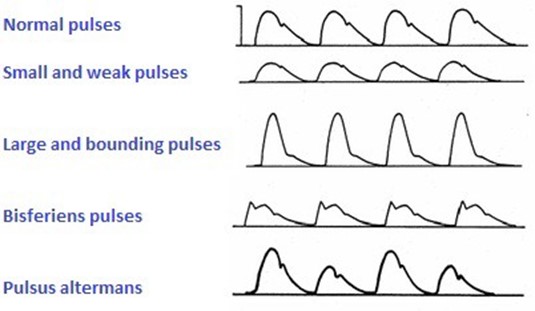The practical nurse (PN) palpates a client's radial pulse and notes that the pulse disappears when light pressure is applied. How should the PN document this finding?
Thready pulse volume.
Missing pulse.
Light pressure applied to pulse.
Pulse skips beats.
The Correct Answer is A
A thready pulse is a weak and rapid pulse that is easily obliterated by light pressure. It indicates poor blood flow and perfusion and may be caused by conditions such as shock, dehydration, or hemorrhage.

The other options are not correct because:
B. A missing pulse is a pulse that is absent or cannot be detected, even with firm pressure. It indicates a complete blockage of blood flow, and may be caused by conditions such as arterial occlusion, embolism, or trauma.
C. Light pressure applied to pulse is not a documentation of the pulse quality, but a description of the technique used to palpate the pulse.
D. Pulse skips beats is a documentation of an irregular pulse rhythm, not a pulse volume. It indicates that the heart beats are unevenly spaced, and may be caused by conditions such as arrhythmia, stress, or caffeine intake.
Nursing Test Bank
Naxlex Comprehensive Predictor Exams
Related Questions
Correct Answer is A
Explanation
The correct answer is Choice A:
"Determine home navigational safety hazards.”. Choice A rationale:
The PN should first assess the client's home for safety hazards that may be contributing to the client's unsteadiness and increased fall risk. Identifying and addressing these hazards can help create a safer environment for the client and potentially prevent accidents.
Choice B rationale:
Encouraging the client to obtain a medical alert device is not the immediate priority in this situation. Addressing the client's safety and identifying potential hazards should be the first step before considering additional measures like medical alert devices.
Choice C rationale:
Recommending that the client obtain a walker is premature without first assessing the home
environment and determining if there are any correctable safety issues. The PN should prioritize safety assessment before recommending any assistive devices.
Choice D rationale:
While maintaining the client's privacy is important, it is not the most urgent action in this scenario. The priority is to assess the client's safety and identify potential hazards in the home. Privacy concerns can be addressed afterward.
Correct Answer is A
Explanation
A thready pulse is a weak and rapid pulse that is easily obliterated by light pressure. It indicates poor blood flow and perfusion and may be caused by conditions such as shock, dehydration, or hemorrhage.

The other options are not correct because:
B. A missing pulse is a pulse that is absent or cannot be detected, even with firm pressure. It indicates a complete blockage of blood flow, and may be caused by conditions such as arterial occlusion, embolism, or trauma.
C. Light pressure applied to pulse is not a documentation of the pulse quality, but a description of the technique used to palpate the pulse.
D. Pulse skips beats is a documentation of an irregular pulse rhythm, not a pulse volume. It indicates that the heart beats are unevenly spaced, and may be caused by conditions such as arrhythmia, stress, or caffeine intake.
Whether you are a student looking to ace your exams or a practicing nurse seeking to enhance your expertise , our nursing education contents will empower you with the confidence and competence to make a difference in the lives of patients and become a respected leader in the healthcare field.
Visit Naxlex, invest in your future and unlock endless possibilities with our unparalleled nursing education contents today
Report Wrong Answer on the Current Question
Do you disagree with the answer? If yes, what is your expected answer? Explain.
Kindly be descriptive with the issue you are facing.
